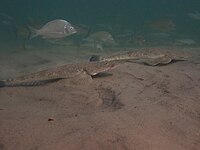Dusky flathead
The Dusky Flathead, scientifically named Platycephalus fuscus, is a popular and prized species among recreational anglers in Australia. Recognized for its unique appearance and delicious taste, the Dusky Flathead also plays a significant role in local cultural and angling tales, making it a beloved catch in the region.
Identifying
Dusky Flathead has a distinctive elongated body, a flattened head, and brown to dark-green shades across the top which transitions to a pale white or yellowish belly. As they mature, larger individuals can exhibit dark spots or blotches. Their eyes are set high and have a clear separation between them.
Similar species
| Fish | Difference in appearance |
|---|---|
| bartailed-flathead.jpg Bartailed Flathead |
Lighter in color with bars on the tail fin. |
| tiger-flathead.jpg Tiger Flathead |
Lighter overall with a tiger stripe pattern. |
How to catch
Dusky Flathead is a bottom-dwelling species, often found in sandy or muddy areas in estuaries, lakes, and coastal bays. Anglers often consider them as ambush predators, meaning they camouflage and wait for prey. The best times to fish for them are during the warmer months when they are most active.
Where & when
Dusky Flatheads are commonly found in estuaries, tidal rivers, coastal bays, and lakes. They prefer shallow sandy or muddy bottoms, often hiding in submerged vegetation. The optimal time to target them is during the warmer months, especially from November to March.
Rods, reels and lines
A light to medium spinning rod paired with a 2500 to 4000-sized reel is ideal. Braided lines in the 6-10 lb range coupled with a fluorocarbon leader of similar strength are often recommended. Shimano Stradic and Penn Battle are popular reel choices among seasoned anglers for this species.
Bait & lures
Live bait, especially prawns, whitebait, and pilchards, is effective. When it comes to lures, soft plastics resembling small fish or prawns, and vibes, work wonders. Brands like ZMan and Squidgies produce popular soft plastics for Flatheads.
Techniques
Casting and slow retrieving soft plastics or vibes along the bottom in areas with submerged vegetation or structures is effective. It's crucial to ensure the lure is close to the bottom, mimicking the natural movement of prey.


